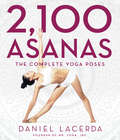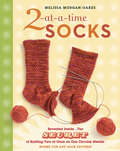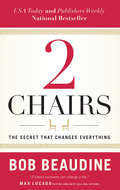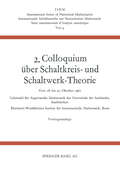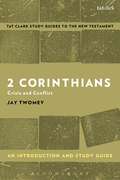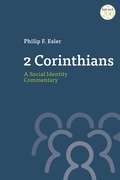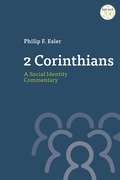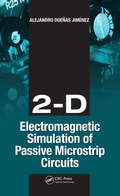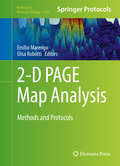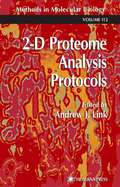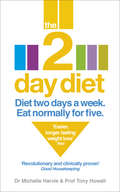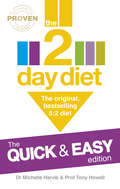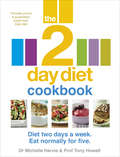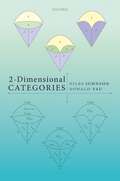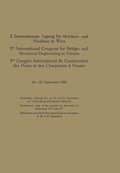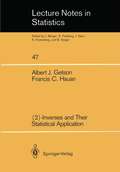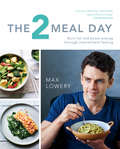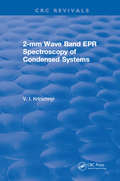- Table View
- List View
2,024 QI Facts To Stop You In Your Tracks
by John Lloyd James Harkin Anne Miller*THE SUNDAY TIMES TOP TEN BESTSELLER* 'I love these books ... the best books ever. Brilliant' Chris Evans A bumper final edition of the most surprising, amazing, and hilarious facts on the planet from the clever-clogs at QI. QI is the smartest comedy show on British television. Here creator John Lloyd and QI Elves James Harkin and Anne Miller bring together 2,024 brain-tickling brand new facts to stop you in your tracks... Did you know that: Humans glow in the dark. The Pope drives a blue Ford Focus. One of the moons of Uranus is called Margaret. Scottish football referees are sponsored by Specsavers. Dogs visiting US National Parks can be certified as Bark Rangers. The world's smallest computer is smaller than a grain of sand. Candyfloss was invented by a dentist. Nobody knows who named the Earth.
2,100 Asanas: The Complete Yoga Poses
by Daniel LacerdaThis fully-illustrated New York Times bestseller categorizes an astonishing 2,100 yoga poses through photographs and descriptions for optimal benefit including adaptations for all levels of expertise and ages. A thoughtful, inspiring, meticulously-crafted guide to the practice of yoga, 2,100 Asanas will explore hundreds of familiar poses along with modified versions designed to bring more healthful options to yogis of all experience and ability. Organized into eight sections for the major types of poses -- standing, seated, core, quadruped, inversions, prone, supine and backbends -- and each section gently progresses from easy to more challenging. Each pose is accompanied by the name of the pose in English and Sanskrit, the Drishti point (eye gaze), the chakras affected and primary benefits.
2,100 Asanas: The Complete Yoga Poses
by Daniel LacerdaThis fully-illustrated New York Times bestseller categorizes an astonishing 2,100 yoga poses through photographs and descriptions for optimal benefit including adaptations for all levels of expertise and ages.A thoughtful, inspiring, meticulously-crafted guide to the practice of yoga, 2,100 Asanas will explore hundreds of familiar poses along with modified versions designed to bring more healthful options to yogis of all experience and ability. Organized into eight sections for the major types of poses -- standing, seated, core, quadruped, inversions, prone, supine and backbends -- and each section gently progresses from easy to more challenging. Each pose is accompanied by the name of the pose in English and Sanskrit, the Drishti point (eye gaze), the chakras affected and primary benefits.
2.5D Printing: Bridging the Gap Between 2D and 3D Applications (The Wiley-IS&T Series in Imaging Science and Technology)
by Carinna Parraman Maria V. Ortiz SegoviaA guide that examines the history and current state of 2.5D printing and explores the relationship between two and three dimensions2.5D Printing: Bridging the Gap Between 2D and 3D Applications examines the relationship between two- and three-dimensional printing and explores the current ideas, methods, and applications. It provides insights about the diversity of our material culture and heritage and how this knowledge can be used to design and develop new methods for texture printing. The authors review the evolving research and interest in working towards developing methods to: capture, measure and model the surface qualities of 3D and 2D objects, represent the appearance of surface, material and textural qualities, and print or reproduce the material and textural qualities. The text reflects information on the topic from a broad range of fields including science, technology, art, design, conservation, perception, and computer modelling. 2.5D Printing: Bridging the Gap Between 2D and 3D Applications provides a survey of traditional methods of capturing 2.5D through painting and sculpture, and how the human perception is able to judge and compare differences. This important text: Bridges the gap between the technical and perceptual domains of 2D and 3D printing Discusses perceptual texture, color, illusion, and visual impact to offer a unique perspective Explores how to print a convincing rendering of texture that integrates the synthesis of texture in fine art paintings, with digital deposition printing Describes contemporary methods for capturing surface qualities and methods for modelling and measuring, and ways that it is currently being used Considers the impact of 2.5D for future technologies 2.5D Printing is a hands-on guide that provides visual inspiration, comparisons between traditional and digital technologies, case studies, and a wealth of references to the world of texture printing. Please visit the companion website at: www.wiley.com/go/bridging2d3d . www.wiley.com/go/bridging2d3d
2.5D Printing: Bridging the Gap Between 2D and 3D Applications (The Wiley-IS&T Series in Imaging Science and Technology)
by Carinna Parraman Maria V. Ortiz SegoviaA guide that examines the history and current state of 2.5D printing and explores the relationship between two and three dimensions2.5D Printing: Bridging the Gap Between 2D and 3D Applications examines the relationship between two- and three-dimensional printing and explores the current ideas, methods, and applications. It provides insights about the diversity of our material culture and heritage and how this knowledge can be used to design and develop new methods for texture printing. The authors review the evolving research and interest in working towards developing methods to: capture, measure and model the surface qualities of 3D and 2D objects, represent the appearance of surface, material and textural qualities, and print or reproduce the material and textural qualities. The text reflects information on the topic from a broad range of fields including science, technology, art, design, conservation, perception, and computer modelling. 2.5D Printing: Bridging the Gap Between 2D and 3D Applications provides a survey of traditional methods of capturing 2.5D through painting and sculpture, and how the human perception is able to judge and compare differences. This important text: Bridges the gap between the technical and perceptual domains of 2D and 3D printing Discusses perceptual texture, color, illusion, and visual impact to offer a unique perspective Explores how to print a convincing rendering of texture that integrates the synthesis of texture in fine art paintings, with digital deposition printing Describes contemporary methods for capturing surface qualities and methods for modelling and measuring, and ways that it is currently being used Considers the impact of 2.5D for future technologies 2.5D Printing is a hands-on guide that provides visual inspiration, comparisons between traditional and digital technologies, case studies, and a wealth of references to the world of texture printing. Please visit the companion website at: www.wiley.com/go/bridging2d3d . www.wiley.com/go/bridging2d3d
2-at-a-Time Socks: Revealed Inside. . . The Secret of Knitting Two at Once on One Circular Needle; Works for any Sock Pattern!
by Melissa Morgan-OakesKnitting one sock is fun and rewarding, but finishing its partner can become a chore that leaves well-intentioned knitters suffering from &“second sock syndrome.&” With this two-at-a-time technique you can easily finish a full pair of socks on the same day. Step-by-step photographs illustrate how to cast on and knit two socks together on one long circular needle, whatever the pattern or shape. Lonely, abandoned single socks are now a thing of the past!
2 Chairs: The Secret That Changes Everything
by Bob BeaudineIn this inspiring book, Bob Beaudine helps you live a life guided by your relationship with God by asking three critical questions.In this world you will have trouble. Count on it!It might be something small or something big, but you know you don't have an answer. You've come to a realization there is a limit to what you can do alone. For such times as these, 2 Chairs asks three vital questions:Does God know your situation?Is it too hard for Him to handle?Does He have a good plan for you?Following these questions, Bob Beaudine offers seven practical steps to walk courageously, faithfully, and cheerfully through your trouble whether it is a minor issue or a major crisis.
2. Colloquium Über Schaltkreis- und Schaltwerk-Theorie (International Series of Numerical Mathematics)
by Johannes Dörr Ernst Peschl Heinz Unger2 Corinthians: Crisis and Conflict (T&T Clark’s Study Guides to the New Testament)
by Jay TwomeyThis guide considers the historical contexts, the literary forms, the social and rhetorical backgrounds, the politics, the theologies, and the reception of 2 Corinthians. Each chapter surveys recent scholarly approaches to the text, focussing especially on critical perspectives that mesh with our contemporary concerns about gender, identity, race and class. 2 Corinthians becomes, in the process, less the work of a single 1st-century writer than a set of fraught, even fractured negotiations between competing interests and impulses, conducted in Paul's voice. The last chapter brings the letter into conversation with Nathaniel Hawthorne's short story 'The Minister's Black Veil' in order to shift the terms of the critical discussion from what Paul meant to how Paul means in later cultural moments.Twomey introduces students to the way 2 Corinthians offers a fascinating but fragmentary glimpse into Paul's continuing ties with the Corinthian community. At the same time, Twomey shows how the letter is the site of many new critical challenges to traditional readings of Paul and early Christianity.In contrast to 1 Corinthians, this 2 Corinthians largely eschews the debates and discussions, the interests and concerns of Paul's correspondents. Instead we find Paul engaged in a multi-pronged defence of his ministry in and beyond Corinth. Over the course of thirteen chapters he runs the gamut of the emotions, rhetorically, from tears to joy to biting anger, while struggling to keep his relationship with (some say, his control over) the community intact.
2 Corinthians: Crisis and Conflict (T&T Clark’s Study Guides to the New Testament)
by Jay TwomeyThis guide considers the historical contexts, the literary forms, the social and rhetorical backgrounds, the politics, the theologies, and the reception of 2 Corinthians. Each chapter surveys recent scholarly approaches to the text, focussing especially on critical perspectives that mesh with our contemporary concerns about gender, identity, race and class. 2 Corinthians becomes, in the process, less the work of a single 1st-century writer than a set of fraught, even fractured negotiations between competing interests and impulses, conducted in Paul's voice. The last chapter brings the letter into conversation with Nathaniel Hawthorne's short story 'The Minister's Black Veil' in order to shift the terms of the critical discussion from what Paul meant to how Paul means in later cultural moments.Twomey introduces students to the way 2 Corinthians offers a fascinating but fragmentary glimpse into Paul's continuing ties with the Corinthian community. At the same time, Twomey shows how the letter is the site of many new critical challenges to traditional readings of Paul and early Christianity.In contrast to 1 Corinthians, this 2 Corinthians largely eschews the debates and discussions, the interests and concerns of Paul's correspondents. Instead we find Paul engaged in a multi-pronged defence of his ministry in and beyond Corinth. Over the course of thirteen chapters he runs the gamut of the emotions, rhetorically, from tears to joy to biting anger, while struggling to keep his relationship with (some say, his control over) the community intact.
2 Corinthians: A Social Identity Commentary (T&T Clark Social Identity Commentaries on the New Testament)
by Philip EslerPhilip F. Esler provides a comprehensive coverage of the issues in 2 Corinthians from the perspective of social identity, with a focus on Paul's leadership.Esler enlists social identity theory-in critical dialogue with existing scholarship-to show how Paul sought to persuade the Corinthian Christ-followers to adopt certain views on four critical issues that had arisen in his relationship with them, with his discourse demonstrably reflecting the ancient Mediterranean culture they shared. Two introductory chapters set out those four issues, summarise the events reflected in 1 and 2 Corinthians, make an initial case for the integrity of the letter against partition theories, explain and defend the use of social identity theory in biblical interpretation, and describe the social identity approach to leadership. In the commentary, Esler explores how Paul re-establishes his leadership role by reconnecting with the Corinthians, urges their participation in the collection for Jerusalem, and defends his position against recently arrived opponents, all the while reinforcing his addressees' social identity as Christ-followers. Prominent features of the commentary fostered by its social identity perspective include its cumulative case for the letter's unity, for Paul's opponents being similar to those in Galatia, and for the interweaving of social and theological dimensions in the text.
2 Corinthians: A Social Identity Commentary (T&T Clark Social Identity Commentaries on the New Testament)
by Philip EslerPhilip F. Esler provides a comprehensive coverage of the issues in 2 Corinthians from the perspective of social identity, with a focus on Paul's leadership.Esler enlists social identity theory-in critical dialogue with existing scholarship-to show how Paul sought to persuade the Corinthian Christ-followers to adopt certain views on four critical issues that had arisen in his relationship with them, with his discourse demonstrably reflecting the ancient Mediterranean culture they shared. Two introductory chapters set out those four issues, summarise the events reflected in 1 and 2 Corinthians, make an initial case for the integrity of the letter against partition theories, explain and defend the use of social identity theory in biblical interpretation, and describe the social identity approach to leadership. In the commentary, Esler explores how Paul re-establishes his leadership role by reconnecting with the Corinthians, urges their participation in the collection for Jerusalem, and defends his position against recently arrived opponents, all the while reinforcing his addressees' social identity as Christ-followers. Prominent features of the commentary fostered by its social identity perspective include its cumulative case for the letter's unity, for Paul's opponents being similar to those in Galatia, and for the interweaving of social and theological dimensions in the text.
2-D and 3-D Image Registration: for Medical, Remote Sensing, and Industrial Applications
by Arthur Ardeshir GoshtasbyTo master the fundamentals of image registration, there is no more comprehensive source than 2-D and 3-D Image Registration. In addition to delving into the relevant theories of image registration, the author presents their underlying algorithms. You'll also discover cutting-edge techniques to use in remote sensing, industrial, and medical applications. Examples of image registration are presented throughout, and the companion Web site contains all the images used in the book and provides links to software and algorithms discussed in the text, allowing you to reproduce the results in the text and develop images for your own research needs. 2-D and 3-D Image Registration serves as an excellent textbook for classes in image registration as well as an invaluable working resource.
2-D Electromagnetic Simulation of Passive Microstrip Circuits
by Alejandro D. JimenezGlobal Demand for Streamlined Design and Computation The explosion of wireless communications has generated a tidal wave of interest and development in computational techniques for electromagnetic simulation as well as the design and analysis of RF and microwave circuits. Learn About Emerging Disciplines, State-of-the-Art Methods2-D Electromagnetic Simulation of Passive Microstrip Circuits describes this simple procedure in order to provide basic knowledge and practical insight into quotidian problems of microstrip passive circuits applied to microwave systems and digital technologies. The text dissects the latest emerging disciplines and methods of microwave circuit analysis, carefully balancing theory and state-of-the-art experimental concepts to elucidate the process of analyzing high-speed circuits. The author covers the newer techniques – such as the study of signal integrity within circuits, and the use of field map interpretations – employed in powerful electromagnetic simulation analysis methods. But why and how does the intrinsic two-dimensional simulation model used here reduce numerical error? Step-by-Step Simulation Provides Insight and UnderstandingThe author presents the FDTD electromagnetic simulation method, used to reproduce different microstrip test circuits, as well as an explanation of the complementary electrostatic method of moments (MoM). Each reproduces different microstrip test circuits that are physically constructed and then studied, using a natural methodological progression to facilitate understanding. This approach gives readers a solid comprehension and insight into the theory and practical applications of the microstrip scenario, with emphasis on high-speed interconnection elements.
2-D Electromagnetic Simulation of Passive Microstrip Circuits
by Alejandro D. JimenezGlobal Demand for Streamlined Design and Computation The explosion of wireless communications has generated a tidal wave of interest and development in computational techniques for electromagnetic simulation as well as the design and analysis of RF and microwave circuits. Learn About Emerging Disciplines, State-of-the-Art Methods2-D Electromagnetic Simulation of Passive Microstrip Circuits describes this simple procedure in order to provide basic knowledge and practical insight into quotidian problems of microstrip passive circuits applied to microwave systems and digital technologies. The text dissects the latest emerging disciplines and methods of microwave circuit analysis, carefully balancing theory and state-of-the-art experimental concepts to elucidate the process of analyzing high-speed circuits. The author covers the newer techniques – such as the study of signal integrity within circuits, and the use of field map interpretations – employed in powerful electromagnetic simulation analysis methods. But why and how does the intrinsic two-dimensional simulation model used here reduce numerical error? Step-by-Step Simulation Provides Insight and UnderstandingThe author presents the FDTD electromagnetic simulation method, used to reproduce different microstrip test circuits, as well as an explanation of the complementary electrostatic method of moments (MoM). Each reproduces different microstrip test circuits that are physically constructed and then studied, using a natural methodological progression to facilitate understanding. This approach gives readers a solid comprehension and insight into the theory and practical applications of the microstrip scenario, with emphasis on high-speed interconnection elements.
2-D PAGE Map Analysis: Methods and Protocols (Methods in Molecular Biology #1384)
by Emilio Marengo and Elisa RobottiExploring the 2-D gel mapping field, the chapters in this book are separated into four different categories: Part I talks about 2-D maps reproducibility and maps modeling; Part II describes the image analysis tools that provide spot volume datasets; Part III is about the statistical methods applied to spot volume datasets to identify candidate biomarkers; and Part IV discusses differential analysis from direct image analysis tools. 2-D PAGE Map Analysis: Methods and Protocols provides a unique approach to 2-D gel mapping, in that it helps users avoid drawbacks due to ignorance of the basic theoretical mechanisms underlying the technique, including data handling and proper tools for spot analysis. Written in the highly successful Methods in Molecular Biology series format, chapters include introductions to their respective topics, lists of the necessary materials, step-by-step, readily reproducible laboratory protocols, and tips on troubleshooting and avoiding known pitfalls.Cutting-edge and thorough, 2-D PAGE Map Analysis: Methods and Protocols, is a useful resource for any scientist or researcher, with a mathematical background, who is interested in 2-D gel mapping.
2-D Proteome Analysis Protocols (Methods in Molecular Biology #112)
by Andrew J. LinkWith the completion of sequencing projects and the advancement of a- lytical tools for protein identification, proteomics—the study of the expressed part of the genome—has become a major region of the burgeoning field of functional genomics. High-resolution 2-D gels can reveal virtually all p- teins present in a cell or tissue at any given time, including posttranslationally modified proteins. Changes in the expression and structure of most cellular proteins caused by differentiation or external stimuli can be displayed and eventually identified using 2-D protein gels. 2-D Proteome Analysis Protocols covers all aspects of the use of 2-D protein electrophoresis for the analysis of biological problems. The contri- tors include many of the leaders in the fields of biochemistry and analytical chemistry who were instrumental in the development of high-resolution 2-D gels, immobilized pH gradients, computer analysis, and mass spectromet- based protein identification methodologies. This book is intended as a benchtop manual and guide both for novices to 2-D gels and for those aficionados who wish to try the newer techniques. Any group using protein biochemistry—especially in the fields of molecular biology, biochemistry, microbiology, and cell biology—should find this book eminently useful. 2-D Proteome Analysis Protocols takes the researcher through the c- plete process of working with 2-D protein gels from making the protein - tract to finally identifying the proteins of interest. It includes protocols for generating 2-D protein extracts from most of the standard model organisms, including bacteria, yeast, nematode, Drosophila, plants, mouse, and human.
The 2-Day Diet: Diet Two Days a Week. Eat Normally for Five.
by Dr Michelle Harvie Professor Tony HowellThe 2-Day Diet is the original, clinically proven 5:2 diet to get you slim and healthy, as developed by acclaimed scientists Dr Michelle Harvie and Prof Tony Howell at Genesis Breast Cancer Prevention (all author proceeds go to this charity). To reach your perfect weight, all you need to do is follow this low-carb intermittent diet for two days a week. For the rest of the week just eat normally but sensibly. It really is that simple, and the science proves it: in trials followers lost more weight than those on continuous calorie-controlled diets, almost twice as much fat, and more centimetres around their waist – and they were more successful at keeping it off!The 2-Day Diet is packed with clear, safe and simple guidance, plus meal planners and 100 delicious and filling recipes to help you on your way. You'll find out how and why the diet works, and the numerous proven health benefits associated with it, including: reducing cancer risks; lowering high blood pressure; anti-ageing effects; and improving well-being, mood and energy levels. This is a unique way of eating that can completely retrain your appetite and rejuvenate your body on a cellular level. Finally, you can enjoy your food and stop worrying about your weight for good.
The 2-Day Diet: The original, bestselling 5:2 diet
by Dr Michelle Harvie Professor Tony HowellThe 2-Day Diet is the original, clinically proven intermittent diet to get you slim and healthy. Unlike other 5:2 diets, there’s no calorie counting, fasting or skipping meals. To reach your perfect weight simply follow the low-carb, low-sugar plan for two days a week, then for the rest of the week eat normally but sensibly with the help of the healthy eating guidelines. The 2-Day Diet is easy to fit around the tastes and appetites of any non-dieters in your life, such as friends and family, and all author proceeds go to Genesis Breast Cancer Prevention.In this new simplified edition, acclaimed scientists Dr Michelle Harvie and Prof Tony Howell at Genesis Breast Cancer Prevention have made it really easy to succeed on The 2-Day Diet. Expect to lose weight, twice as much fat and more centimetres around your waist than you would on a standard calorie-controlled diet. You can also benefit from the numerous other health benefits associated with this diet, including: reduced cancer risks; lowered high blood pressure; anti-ageing effects; and improved well-being, mood and energy levels.With clear, safe and simple guidance, plus meal planners and delicious recipes, this unique way of eating means you can enjoy your food and stop worrying about your weight for good.
The 2-Day Diet Cookbook: Diet Two Days A Week - Eat Normally For Five
by Dr Michelle Harvie Professor Tony HowellThe 2-Day Diet is the clinically proven 5:2 diet developed by acclaimed scientists Dr Michelle Harvie and Prof Tony Howell at Genesis Breast Cancer Prevention (all author proceeds go to this charity). Their intermittent diet has taken the nation by storm as more and more people discover the diet that really works. It’s not about counting calories, fasting or going hungry – simply follow the straightforward low-carb eating plan for two days per week then eat normally but sensibly for the other five. In this beautifully illustrated cookbook, you’ll find 65 delicious, healthy recipes for every day of the week, with ideas for both restricted and unrestricted days. On The 2-Day Diet you can enjoy filling, tasty food all day long - from breakfast through to dinner - and still lose more weight and up to twice as much fat as on a standard calorie-controlled diet. You will also benefit from a wide range of health benefits associated with the diet, such as reducing insulin and levels of other hormones and inflammation in the body known to cause cancer, lowering high blood pressure, and improving well-being, mood and energy levels. Recipes for restricted days include:- Stuffed tarragon chicken with bacon and roasted veg- Chimichurri steak- Spiced turkey burgers with guacamole- Salmon with roasted fennel, leeks and tomatoes- Blackberry frozen yoghurt- Melon, mint and pineapple granitaWith nutritionally balanced, easy-to-prepare and delicious recipes like these, along with tips, meal plans and a quick-reference guide to what to eat, The 2-Day Diet Cookbook shows you how to love food, lose weight and keep it off forever.
2-Dimensional Categories
by Niles Johnson Donald YauCategory theory emerged in the 1940s in the work of Samuel Eilenberg and Saunders Mac Lane. It describes relationships between mathematical structures. Outside of pure mathematics, category theory is an important tool in physics, computer science, linguistics, and a quickly-growing list of other sciences. This book is about 2-dimensional categories, which add an extra dimension of richness and complexity to category theory. 2-Dimensional Categories is an introduction to 2-categories and bicategories, assuming only the most elementary aspects of category theory. A review of basic category theory is followed by a systematic discussion of 2-/bicategories, pasting diagrams, lax functors, 2-/bilimits, the Duskin nerve, 2-nerve, internal adjunctions, monads in bicategories, 2-monads, biequivalences, the Bicategorical Yoneda Lemma, and the Coherence Theorem for bicategories. Grothendieck fibrations and the Grothendieck construction are discussed next, followed by tricategories, monoidal bicategories, the Gray tensor product, and double categories. Completely detailed proofs of several fundamental but hard-to-find results are presented for the first time. With exercises and plenty of motivation and explanation, this book is useful for both beginners and experts.
2. Internationale Tagung für Brücken- und Hochbau in Wien (pdf): vorläufiger Abdruck der am 24. und 25. September zur Verhandlung gelangenden Referate = 2nd International Congress for Bridge- and Structural Engineering in Vienna = 2me Congrès International de Construction des Ponts et des Charpentes à Vienne
by International Congress for Bridge and Structural EngineeringVorläufiger Abdruck der am 24. und 25. September zur Verhandlung gelangenden Referate / Preliminary copy of the reports be discussed on September 24th and 25th / Publication provisoire des rapports mis en discussion le 24 et 25 septembre
{2}-Inverses and Their Statistical Application (Lecture Notes in Statistics #47)
by Albert J. Getson Francis C. HsuanMuch of the traditional approach to linear model analysis is bound up in complex matrix expressions revolving about the usual generalized inverse. Motivated by this important role of the generalized inverse. the research summarized here began as an interest in understanding. in geometric terms. the four conditions defining the qnique Moore-Penrose Inverse. Such an investigation. it was hoped. might lead to a better understanding. and possibly a simplification of. the usual matrix expressions. Initially this research was begun by Francis Hsuan and Pat Langenberg, without knowledge of Kruskal's paper published in 1975. This oversight was perhaps fortu nate. since if they had read his paper they may not have continued their effort. A summary of this early research appears in Hsuan. Langenberg and Getson (1985). This monograph is a summary of the research on {2}-inverses continued by Al Getson. while a graduate student. in collaboration with Francis Hsuan of the Depart ment of Statistics. School of Business Administration. at Temple University. Philadelphia. The literature on generalized inverses and related topics is extensive and some of what is present here has appeared elsewhere. Generally. this literature is not presented from the point of view of {2}-inverses. We have tried to do justice to . the relevant published works and appologize for those we have either overlooked or possibly misrepresented.
The 2 Meal Day: Burn Fat And Boost Energy Through Intermittent Fasting
by Max Lowery'I love the 2 Meal Day! I feel healthy, happy and full of energy' Suki WaterhouseWelcome to intermittent fasting - eat just two meals a day, either breakfast and lunch or lunch and dinner, to burn fat and get fit fast. Rather than grazing on food all day or having to do complicated calorie calculations for the 5:2 diet, simply eat two meals to lose weight, reduce hunger and feel more energised. Choose your two meals from Max's delicious, nutritious and easy-to-prepare recipes; start the day with Salmon Mini Frittatas or a Breakfast Burrito; Lunch on Thai Green Chicken Curry or Tuna Casserole or enjoy Creamy Mushroom and Parmesan Risotto or Sea Bass Sauce Vierge for Dinner. There are even healthier desserts to satisfy your sweet tooth without over-indulging - choose from Two-Ingredient Chocolate Mousse or Banana Pancakes. Max shows how to combine your 2-meal day with High-Intensity Interval Training (HIIT) - short duration and maximum effort exercises - and resistance workouts to help you drop fat and get fit quickly. So ditch the calorie-counting and the sugar highs and lows and enjoy two meals a day alongside Max's workouts for a leaner, fitter, healthier body.
2-mm Wave Band EPR Spectroscopy of Condensed Systems
by V. I. KrinichnyiThis is the first book to summarize the problems of using modern high-resolution 2-mm wave band EPR spectroscopy in an interdisciplinary field for the investigation of various condensed systems. The material is well illustrated and the applications are as diverse as possible. The main subjects included are: unique characteristics of 2-mm EPR spectroscopy and appropriate experimental techniques, dynamics and polarity of radical microenvironment in model and biological systems, and the nature of charge carriers and charge transfer mechanisms in organic polymer semiconductors.

